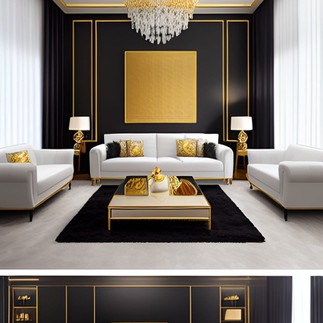Interior Designing Colors: How to Choose the Perfect Palette for Your Home
- Prem Praneeth Kota
- May 4, 2023
- 3 min read
When it comes to interior design, color is one of the most important elements to consider. Choosing the right color palette can make a significant impact on the overall look and feel of a room. However, with so many options to choose from, it can be overwhelming to decide on the perfect colors for your home. In this blog, we'll explore some tips and tricks to help you choose the perfect interior designing colors for your space.
Consider the Mood You Want to Create
The colors you choose can have a significant impact on the mood of a room. For example, warm colors such as red, orange, and yellow can create a sense of energy and excitement, while cool colors like blue, green, and purple can evoke a calming and relaxing atmosphere. Before choosing your colors, consider the mood you want to create in the room.
Think About the Lighting
Lighting can play a significant role in how colors appear in a room. Natural light can make colors appear brighter, while artificial lighting can create shadows and change the hue of a color. When choosing your colors, take into consideration the type of lighting in the room and how it may affect the colors.
Choose a Dominant Color
To create a cohesive look, choose a dominant color for the room. This color should be used in the largest amount in the space. You can then choose complementary colors to accent and enhance the dominant color.

Consider the Function of the Room
The function of the room can also influence the colors you choose. For example, a bedroom may benefit from calming colors, while a home office may require energizing colors. Think about the activities that will take place in the room and choose colors that will enhance the experience.
Don't Be Afraid to Experiment
Lastly, don't be afraid to experiment with colors. Try different combinations and shades to see what works best for your space. You can also use online tools and color swatches to help visualize how the colors will look in the room.
In conclusion, choosing the perfect color palette for your home can be a fun and rewarding experience. By considering the mood, lighting, function, and dominant color of the room, you can create a space that is both aesthetically pleasing and functional. So, go ahead and experiment with different interior designing colors to find the perfect combination for your home.
Consider the Color Wheel
The color wheel is a useful tool that can help you choose complementary colors that work well together. Complementary colors are opposite each other on the color wheel, such as blue and orange or yellow and purple. Using complementary colors in a room can create a vibrant and harmonious look.
Think About the Undertones
When choosing colors, it's important to consider the undertones. Undertones are the underlying colors in a shade. For example, a gray paint color may have blue, green, or purple undertones. Understanding the undertones can help you choose complementary colors that work well together.
Use Accent Colors
Accent colors can add interest and depth to a room. These are usually bold or bright colors that are used in small doses to create a focal point in the room. For example, a neutral room can be enhanced with pops of red or yellow in throw pillows or artwork.
Use Texture to Add Visual Interest
Using texture is another way to add visual interest to a room. Textured materials such as woven blankets, shag rugs, and velvet curtains can add depth and dimension to a space. Textured materials can also be used to create contrast with smooth surfaces and create a balanced look.
Take Inspiration from Nature
Nature can be a great source of inspiration for color palettes. The colors found in nature, such as greens, blues, and browns, can create a calming and organic atmosphere in a room. Consider using natural materials such as wood or stone to complement these colors and add to the natural aesthetic.
In conclusion, choosing the perfect interior designing colors for your home can seem daunting, but with these tips, you'll be able to create a cohesive and harmonious space that reflects your personal style. Remember to consider the mood, lighting, function, dominant color, color wheel, undertones, accent colors, texture, and nature when choosing your colors. And most importantly, have fun with it and trust your instincts!




































Comments